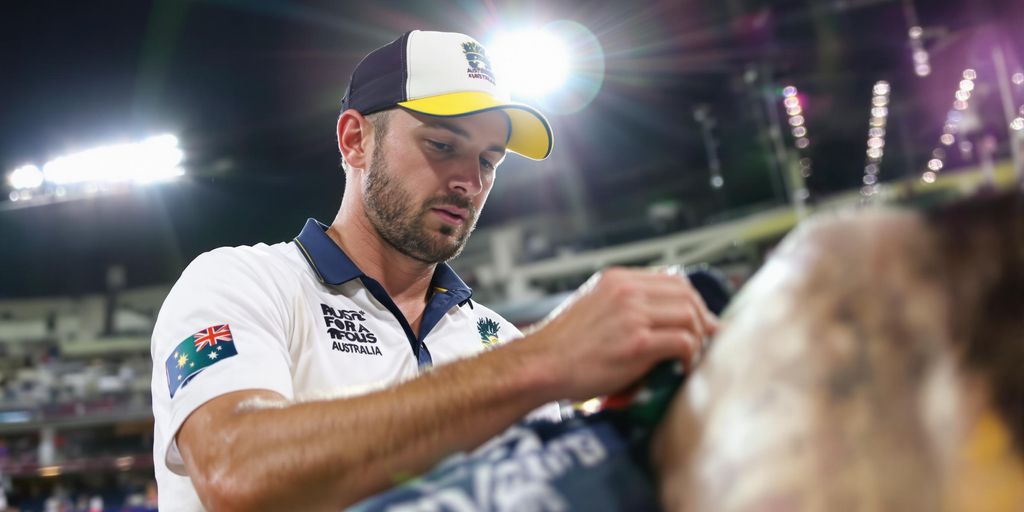Understanding The Role Of The Australian Cricket Team Physiotherapist
Key Responsibilities During Matches
Okay, so what does the physio actually do during a cricket match? It’s more than just running on with the magic sponge! A big part of it is being ready to respond to any injuries that might pop up. They’re also there to help players manage any niggles they’ve already got, doing things like taping ankles or giving quick massages to keep them going. Basically, they’re the first port of call if anyone goes down, making sure the player is safe and can get the right treatment.
Injury Prevention Strategies
It’s not all about fixing things after they break. A good chunk of the physio’s job is about stopping injuries from happening in the first place. This means working with the players on their warm-ups, making sure they’re stretching properly, and keeping an eye on their technique to spot anything that might cause problems down the line. They also work with the strength and conditioning coaches to make sure the players are physically ready for the demands of the game. It’s a whole team effort to keep everyone on the park.
Collaboration With Coaching Staff
The physio isn’t off in their own little world; they’re a key part of the whole team setup. They need to be in constant communication with the coaches, letting them know about any player concerns or injuries. This helps the coaches make informed decisions about who’s fit to play and how hard they can push them. It’s a two-way street, with the coaches also giving the physio feedback on how the players are coping with the training load. Good communication is vital for keeping everyone healthy and performing at their best.
The physio’s role is all about keeping the players on the field, performing at their peak. It’s a mix of reacting to problems, preventing them in the first place, and working closely with the rest of the team to make sure everyone’s on the same page.
The Importance Of Injury Management
Injury management is absolutely vital in professional cricket. It’s not just about patching players up; it’s about keeping them on the field and performing at their best. A well-structured injury management plan can be the difference between a successful season and a disappointing one. We’re talking about careers here, not just games.
Immediate Response To Injuries
When an injury happens on the field, the first few minutes are critical. Having a clear protocol for assessing and managing acute injuries is essential. This includes everything from concussion management to dealing with muscle strains. Quick, accurate assessment allows for appropriate treatment and prevents further damage. It’s all hands on deck, and everyone needs to know their role.
Long-Term Rehabilitation Plans
It’s not enough to just get a player back on the field; we need to make sure they’re fully recovered and less likely to get injured again. This means developing individualised rehab programmes that address the specific needs of each player. These plans often involve a combination of physiotherapy, strength and conditioning, and gradual return-to-play protocols. It’s a marathon, not a sprint.
Monitoring Player Health
Keeping tabs on player wellbeing is a continuous process. This involves:
- Regular screening for potential problems.
- Tracking training loads to avoid overtraining.
- Monitoring sleep, nutrition, and stress levels.
- Using data to identify trends and predict potential injuries.
By closely monitoring player health, we can identify issues early and intervene before they become serious problems. This proactive approach is key to keeping players healthy and on the field. It’s about prevention as much as cure.
Daily Routine Of A Cricket Physiotherapist

Pre-Game Preparations
Right, so before a match, things get pretty hectic. It all starts well before the first ball is even bowled. The main focus is getting the players physically ready to perform at their peak. This involves a lot of individual assessments, making sure no one’s carrying any niggles that could turn into something worse. We’re talking hands-on treatment – massage, stretching, joint mobilisation – whatever each player needs. Then there’s strapping and taping to provide extra support where it’s needed. It’s a bit like preparing a race car before a big race; every little detail matters.
In-Game Responsibilities
During the game, I’m basically on standby. Hopefully, I’m not needed too much, because that means everyone’s staying healthy! But if someone goes down, I’m straight out there to assess the injury. It could be anything from a rolled ancle to a more serious collision. The first thing is to figure out how bad it is and whether they can continue playing. If they can’t, it’s about getting them off the field safely and starting immediate treatment. It’s a high-pressure situation, and you’ve got to make quick decisions.
Post-Game Assessments
After the final wicket falls, the work isn’t over. Post-game is all about assessing any new injuries or complaints that cropped up during the match. We’re looking at everything from minor strains to more significant issues that need further investigation. This is also when we start planning for recovery. It might involve ice baths, compression garments, or just some gentle stretching to help the players recover. It’s about getting ahead of the game and making sure they’re in the best possible shape for the next match.
Post-match, a key part of the routine involves detailed communication with the coaching staff. This ensures everyone is on the same page regarding player fitness and availability for upcoming games. It’s a collaborative effort to optimise player well-being and performance.
The Impact Of Sports Science On Performance
Utilising Data For Injury Prevention
Sports science has become a game-changer in cricket, especially when it comes to keeping our players on the field. We’re not just relying on gut feelings anymore; we’re using data to make informed decisions. This means tracking everything from player workloads to sleep patterns to identify potential injury risks before they even become a problem. For example, wearable tech gives us real-time insights into the stress on a bowler’s body, allowing us to adjust their training schedule to prevent stress fractures. It’s all about being proactive, not reactive.
Optimising Training Loads
It’s a delicate balance – pushing players hard enough to improve, but not so hard that they break down. Sports science helps us find that sweet spot. We use things like GPS tracking and heart rate monitoring to understand how players are responding to different training drills. This allows us to tailor training programmes to each individual’s needs, ensuring they’re getting the most out of every session without overdoing it. This personalised approach is key to maximising performance and minimising the risk of injury.
Enhancing Recovery Techniques
Recovery is just as important as training, and sports science has given us a whole new toolkit to work with. We’re talking about everything from ice baths and compression garments to sleep optimisation strategies and nutrition plans.
Here are some recovery techniques we use:
- Cryotherapy: Short bursts of extreme cold to reduce inflammation.
- Active Recovery: Light exercise to promote blood flow and muscle repair.
- Nutrition: Tailored diets to replenish energy stores and support muscle recovery.
By using these techniques, we can help players bounce back faster after tough matches and training sessions, ensuring they’re always ready to perform at their best. It’s about giving them the tools they need to recover effectively, so they can stay fresh and focused throughout the season.
Building A Cohesive Medical Team
It’s not just about having the best individual physios, doctors, and trainers; it’s about how well they all work together. A champion cricket team needs a medical team that functions like a well-oiled machine. Everyone needs to be on the same page, communicating effectively, and trusting each other’s judgement.
Collaboration With Other Health Professionals
Think of it like this: the physio might spot a potential issue during a training session, but they need to be able to quickly discuss it with the team doctor to get a diagnosis and plan of action. This could involve SMA Sports Doctors or even external specialists. It’s about bringing all the expertise to the table to make the best decisions for the player’s health and performance.
Communication With Players
Open and honest communication with the players is absolutely vital. They need to feel comfortable talking about any niggles or concerns they have, no matter how small they seem. If a player doesn’t trust the medical team, they’re less likely to report issues early, which can lead to bigger problems down the track. It’s about building a relationship where players feel heard and understood.
Integrating Feedback From Coaches
The coaches have a unique perspective on the players’ physical condition, as they see them day in and day out during training and matches. The medical team needs to listen to this feedback and use it to inform their assessments and treatment plans. It’s a two-way street: the medical team also needs to be able to communicate their concerns to the coaches, so they can adjust training loads or playing schedules as needed.
It’s all about creating a supportive environment where everyone is working towards the same goal: keeping the players healthy, performing at their best, and winning games. When the medical team, coaches, and players are all on the same page, that’s when the magic happens.
Training The Next Generation Of Physiotherapists
We reckon it’s vital to keep the Aussie cricket team at the top of their game, and that means investing in the future of sports physio. We’re not just patching up injuries; we’re building a legacy of excellence by training the next wave of therapists. It’s about passing on the knowledge, the skills, and the passion for keeping our athletes in peak condition.
Internship Opportunities
We offer a ripper of an internship programme that throws young physios right into the deep end. They get to work alongside our experienced team, seeing firsthand how we handle everything from pre-game prep to post-match recovery. It’s a hands-on experience that you just can’t get in a classroom. Imagine being there, learning how to manage acute injuries on the spot, or developing long-term rehab plans for our star players. It’s intense, but it’s also incredibly rewarding. These internships are designed to give them a real taste of what it’s like to work in elite sports, preparing them for the challenges and triumphs that lie ahead. We’ve seen some amazing talent come through these programmes, and many have gone on to do great things in the field. It’s all about giving them the opportunity to shine and contribute to the future of Australian cricket. The collaboration between the medical professionals and the coaching staff was key to managing the intense schedule. With back-to-back games, managing fatigue and minor injuries was a constant challenge. APA Sports Physiotherapist played a central role in helping the athletes maintain their performance across the entire tournament.
Mentorship Programmes
Our mentorship programme is all about pairing up young guns with seasoned pros. It’s a chance for them to learn from the best, ask questions, and get guidance on everything from treatment techniques to career development. These mentors aren’t just sharing their knowledge; they’re also providing support and encouragement, helping the next generation navigate the complexities of sports physio. It’s a two-way street, too. Our mentors get a fresh perspective and a chance to reflect on their own practises. It’s about building relationships and creating a culture of continuous learning within the team.
Real-World Experience In Elite Sports
Nothing beats getting your hands dirty and experiencing the real deal. That’s why we make sure our trainees get plenty of opportunities to work with the team in high-pressure situations. Whether it’s a Test match at the Gabba or a tour overseas, they’re right there on the sidelines, learning how to think on their feet and make quick decisions. It’s not always glamorous, but it’s always valuable. They’ll be dealing with everything from niggles and strains to full-blown injuries, and they’ll be learning how to adapt to different environments and player needs. It’s this real-world experience that sets them apart and prepares them to be the best sports physios they can be.
Here’s a quick look at the kind of experience they get:
- Assisting with pre-game warm-ups and stretching routines.
- Providing immediate first aid and injury assessment during matches.
- Implementing rehabilitation programmes under the supervision of senior physios.
- Learning about the use of technology in sports physiotherapy.
Challenges Faced By The Physiotherapy Team

Being a physio for the Aussie cricket team isn’t all sunshine and wickets. There are some serious hurdles we face, especially when the pressure’s on.
Managing Fatigue During Tournaments
Tournaments are brutal. Back-to-back matches, constant travel, and the sheer intensity of it all take a massive toll. Players are pushing their bodies to the absolute limit, and it’s our job to keep them going. This means carefully monitoring their workload, ensuring adequate recovery, and making tough calls about who can play and when. It’s a constant balancing act to prevent overuse injuries and burnout.
Dealing With Acute Injuries
Cricket’s a contact sport, and injuries happen – fast. From a nasty shoulder injuries sustained diving for a catch to a rolled ancle during a quick single, we need to be ready to respond instantly. This means having a clear plan for immediate assessment, treatment, and return-to-play protocols. The pressure to get players back on the field ASAP is immense, but we can’t compromise their long-term health.
Adapting To Player Needs
Every player is different. They have unique injury histories, playing styles, and recovery rates. What works for one player might not work for another. We need to be adaptable and tailor our treatment plans to each individual’s specific needs. This requires building strong relationships with the players, understanding their bodies, and being willing to adjust our approach as needed.
It’s not just about treating injuries; it’s about understanding the whole athlete – their physical and mental state. We need to be part psychologist, part detective, and part miracle worker sometimes. The key is open communication and a willingness to listen.
Here’s a quick look at some common challenges:
- Long hours and travel
- High-pressure environment
- Limited resources at times
The Role Of Technology In Sports Physiotherapy
Technology has completely changed the game for sports physios, hasn’t it? It’s not just about ice packs and massage anymore. We’re talking serious data analysis, cutting-edge treatment tools, and ways to keep players in top nick using all sorts of gadgets. It’s a pretty exciting time to be in the field, actually.
Use Of Wearable Devices
Wearable tech is a massive deal. We’re using things like GPS trackers and heart rate monitors to get a real-time look at how players are performing and coping with the demands of the game. This data helps us to:
- Monitor training loads to prevent overtraining.
- Identify early signs of fatigue or potential injury.
- Personalise training programmes based on individual needs.
It’s like having a constant health check on each player. We can see how they’re responding to different drills, how well they’re recovering, and make adjustments to their training accordingly. It’s all about being proactive rather than reactive.
Telehealth Consultations
Telehealth has become increasingly important, especially with the amount of travel involved in cricket. It allows us to:
- Provide remote consultations to players who are away on tour.
- Monitor their progress and adjust treatment plans as needed.
- Offer support and advice even when we can’t be there in person.
It’s not quite the same as being there face-to-face, but it’s a great way to stay connected and ensure players are getting the care they need, no matter where they are. Plus, it’s super handy for quick check-ins and addressing minor concerns before they become bigger problems. It’s also useful for preventive care.
Data Analysis For Performance Improvement
Data analysis is where it all comes together. We’re collecting so much information these days, but it’s only useful if we can make sense of it. Sophisticated software helps us to identify patterns, trends, and potential risk factors. This allows us to:
- Develop targeted injury prevention programmes.
- Optimise training loads for maximum performance.
- Track the effectiveness of different treatment strategies.
Here’s a quick example of how we might use data to improve a player’s performance:
| Metric | Baseline | Current | Goal |
|---|---|---|---|
| Sprint Speed | 28 km/h | 29 km/h | 30 km/h |
| Heart Rate | 160 bpm | 155 bpm | 150 bpm |
| Recovery Time | 15 mins | 12 mins | 10 mins |
By tracking these metrics, we can see how a player is progressing and make adjustments to their training to help them reach their goals. It’s all about using data to make informed decisions and get the best out of each player.
Psychological Support In Physiotherapy
It’s easy to forget the mental side of things when you’re dealing with elite athletes. But honestly, the psychological aspect of recovery and performance is just as important as the physical stuff. We’re not just fixing muscles and joints; we’re also helping players deal with the pressure, the setbacks, and the mental grind of professional sport.
Building Player Confidence
One of the biggest things we do is help players rebuild their confidence after an injury. Coming back from a serious injury can be a real mental battle. It’s about getting them to trust their body again, to push themselves without being afraid of re-injury. We use a lot of positive reinforcement and set small, achievable goals to help them see progress and regain that self-belief. It’s not just about physical strength; it’s about mental fortitude too.
Mental Resilience Training
We work with sports psychologists to incorporate mental resilience training into our programmes. This might involve things like visualisation techniques, mindfulness exercises, and strategies for managing stress and anxiety. The goal is to equip players with the mental tools they need to perform under pressure and bounce back from setbacks, both on and off the field. It’s about building that mental toughness that separates good players from great ones.
Support During Recovery
Recovery can be a lonely and frustrating time for athletes. They’re often sidelined, away from their teammates, and feeling isolated. We make sure they have the support they need, both from us and from the wider team. This might involve regular check-ins, helping them stay connected with their teammates, and providing a listening ear when they need to vent. It’s about creating a supportive environment where they feel comfortable sharing their concerns and know that they’re not alone in their journey.
It’s easy to underestimate the mental toll that injuries and high-pressure situations can take on athletes. As physios, we play a key role in providing that psychological support, helping them stay positive, focused, and resilient throughout their careers. It’s about treating the whole person, not just the injury.
Success Stories From The Field
Notable Recoveries
We’ve seen some ripper comebacks over the years, haven’t we? Think back to blokes like Nathan Lyon, who’ve bounced back from serious injuries to keep spinning webs around batsmen. These recoveries aren’t just about getting back on the field; they’re about getting back to peak performance. It’s a testament to the hard yakka put in by the players and the physio team.
Impact On Team Performance
When key players are fit and firing, the whole team lifts. It’s as simple as that. A classic example is when a fast bowler, nursed back to full fitness, tears through the opposition’s batting lineup. That’s the kind of impact we’re talking about. It’s not just about individual brilliance; it’s about how that brilliance contributes to the overall team effort.
Player Testimonials
Players often speak about the physio team as being their rock. Here’s what a few of them have said:
- "Without the physio team, I wouldn’t have made it back from that shoulder injury. They were there every step of the way."
- "The physios aren’t just healers; they’re also motivators. They kept me going when I thought I couldn’t."
- "Having the physio team around gives you confidence. You know you’re in good hands."
The physio team’s work often goes unnoticed by the casual observer, but within the team, their contribution is highly valued. They’re the unsung heroes who keep the show on the road.
It’s not just about fixing injuries; it’s about building trust and creating a supportive environment where players feel confident and ready to perform.
Future Trends In Sports Physiotherapy
Sports physiotherapy is always changing, and it’s pretty exciting to think about where things are headed. We’re seeing some cool stuff already, but the next few years should bring even bigger changes to how we keep our athletes in top shape.
Innovations In Treatment Techniques
We’re moving beyond just ice and rest, that’s for sure. Think more targeted therapies. Things like blood flow restriction training are becoming more common, and we’re seeing a lot of interest in shockwave therapy for tendon issues. Plus, there’s a growing push for individualised treatment plans based on an athlete’s specific needs and how their body responds. It’s not one-size-fits-all anymore. We’re also looking at ways to use virtual reality to help with rehab, making it more engaging and effective.
Evolving Role Of Physiotherapists
The physio’s role is expanding. It’s not just about fixing injuries; it’s about performance optimisation. We’re getting more involved in pre-season conditioning, working with coaches to design training programmes that minimise injury risk. We’re also becoming key players in helping athletes manage their mental wellbeing, especially during long tournaments or after setbacks. It’s a more holistic approach, really.
The Future Of Sports Medicine
Sports medicine is becoming more integrated. You’ve got physios, doctors, strength and conditioning coaches, nutritionists, and psychologists all working together. This team approach means athletes get the best possible care, with everyone on the same page. We’re also seeing a greater emphasis on research and data analysis to inform treatment decisions. It’s about using evidence to guide what we do, rather than just relying on tradition. Plus, with telehealth becoming more accepted, we can provide support to athletes no matter where they are in the world.
The future of sports physio is all about being proactive, individualised, and integrated. It’s about using the latest tech and research to keep athletes healthy, performing at their best, and enjoying their sport for longer.
Wrapping It Up: The Unsung Heroes of Sports
So, there you have it. The role of a physiotherapist in the Australian cricket team is pretty vital, even if it often flies under the radar. They’re not just there to patch up injuries; they’re part of a bigger picture, helping players stay fit and ready to go. It’s all about teamwork, communication, and a whole lot of dedication. The physios work tirelessly behind the scenes, making sure the athletes can perform at their best, game after game. And for those just starting out in this field, like the students from Nottingham, it’s a chance to learn from the best and get a taste of what it’s really like in the world of elite sports. At the end of the day, it’s about keeping the game alive and kicking, and that’s something everyone can appreciate.




